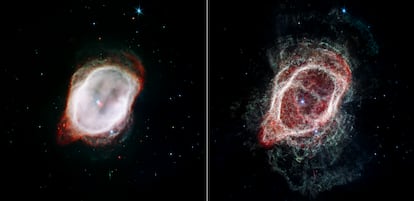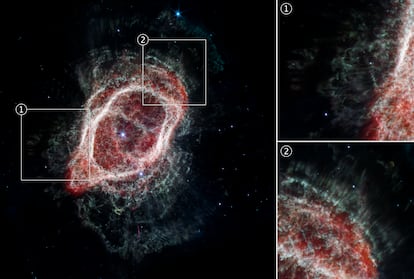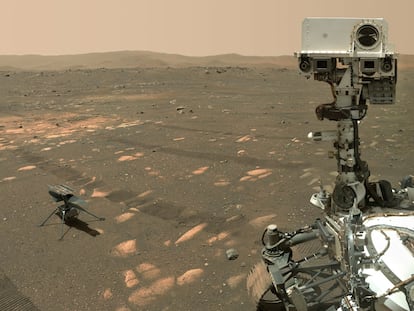The Southern Ring Nebula mystery: A complex case of multiple stars and a stellar corpse
A ring-shaped formation rich in molecules reveals its secrets thanks to observations by the James Webb space telescope

The Persian poet Rumi said that “the wound is the place where the light enters.” These beautiful words have helped many sensitive souls who have listened to them throughout the ages. But the 13th-century scholar might as well have been talking about the exquisite details shown by the James Webb Space Telescope’s observations of the Southern Ring Nebula, also known since the late 19th century as NGC 3132. In the combined images from two of the cameras, it is easy to see how the fine rays of light from the central star pass through the planetary nebula through cracks created in the structure of gas and dust. The light sneaks through there, like water through the cracks or sunlight through the clouds. And there is still much more to read in those images.
The complex history of this object, which has just been published in the journal Nature Astronomy, shows that the formation of the nebula does not appear to have been the work of a single star. Not even two. There are at least four stars involved, maybe five, and the main suspect, the bright blue-white star at the center of the telescope’s images, has been cleared without charges. It orbits the dying star, the main culprit for the beautiful stellar corpse, but it was simply too far from the scene. It is 1,300 times the Earth-Sun distance from the nebula’s central star, or about 200 times the distance from the Sun to the nearest star, Proxima Centauri. And that, in this case, is quite far.
The reconstruction goes back a few thousand years in the past of the multiple star system and in the traces it has left in the planetary nebula. We have a star, the protagonist, which lifted a great weight off its shoulders, or perhaps we might say that it shed its entire envelope. We know that it was almost three times more massive than the Sun, because the blue star, the one passing by, told us so with the help of the space telescope GAIA. And we have also inferred that now only about 0.6 times the mass of the Sun remains of it in the form of a white dwarf; a structure that, despite having run out of nuclear fuel, manages to overcome gravitational contraction thanks to quantum physics.

The boxed-in structure revealed by images of the nebula is multi-layered. Moving outward from the star’s position, it first contains a bubble of gas at 10 million degrees Kelvin, followed by a shell of gas at 10,000ºK mixed with dust, then a colder area that is observed mainly in the form of hydrogen molecules and is just at 100ºK. The central ionized bubble is the hottest and as such is homogeneous, but it is surrounded by a halo of molecular hydrogen.
In this case, the molecular halo is older than the rest of the planet and is pierced by spiral structures. The details with which this cooler structure has been observed thanks to the Webb telescope allow us to infer the presence of another star. The separation between the arcs allows us to measure the period of the orbit, or in other words, the distance from the star that has helped to create them. A distance of between 40-60 times the Earth-Sun distance is inferred (Neptune is at a distance of 30 from the Sun measured in those units as a reference). These spiral structures are similar to those recently found by Webb in a massive binary star. In this case we cannot determine if the companion is still there or has merged with the protagonist of this story.
Going back to the central star, the analysis of the data from Webb has also revealed the presence of an excess of emission in the position held by the star, from which the presence of a disk of material can be deduced in the form of dust similar to the Kuiper belt in the Solar System. And to form it, another star is needed. There are now four: the protagonist whose entrails we are observing, the star that formed the disc, the star that generated the spiral structures and the one that passed by. This reconstruction of events, which made it to the cover of Nature Astronomy, has been led by Orsola de Marco from Macquarie University in Australia who put together a team of almost 70 researchers, many of whom, like myself, are located in Spain and are affiliated with the Center for Astrobiology (INTA-CSIC), Gran Telescopio de Canarias (GRANTECAN), Andalusia Astrophysics Institute (IAA-CSIC), Canary Islands Astrophysics Institute (IAC) and the National Astronomical Observatory (OAN/IGN).
In most of the universe, the evolution of the stars does not occur in isolation: they have companions that mainly affect their later states. We are dependent on the interactions between these binary stars to understand, for example, the chemical enrichment of the universe generated by supernova explosions. The problem is that it is very difficult to measure the impact of the presence of other stars and their relative importance because we do not have access to the entire evolution, and often not to the final products either, and the result often also depends on the distance between the stars.
In this particular nebula we see the material resulting from the interaction. Its shape reveals how it was thrown in specific directions due to the presence of a multitude of companion stars. Fundamentally, we see it because there is light, because the material is being illuminated by the central star, the protagonist. In a few thousand years, this light will go out, leaving behind a cold and empty scene and depriving us of the ability to decipher it.
Eva Villaver is a researcher at the Astrobiology Center (CAB), CSIC-INTA in Madrid, Spain.
Sign up for our weekly newsletter to get more English-language news coverage from EL PAÍS USA Edition
Tu suscripción se está usando en otro dispositivo
¿Quieres añadir otro usuario a tu suscripción?
Si continúas leyendo en este dispositivo, no se podrá leer en el otro.
FlechaTu suscripción se está usando en otro dispositivo y solo puedes acceder a EL PAÍS desde un dispositivo a la vez.
Si quieres compartir tu cuenta, cambia tu suscripción a la modalidad Premium, así podrás añadir otro usuario. Cada uno accederá con su propia cuenta de email, lo que os permitirá personalizar vuestra experiencia en EL PAÍS.
¿Tienes una suscripción de empresa? Accede aquí para contratar más cuentas.
En el caso de no saber quién está usando tu cuenta, te recomendamos cambiar tu contraseña aquí.
Si decides continuar compartiendo tu cuenta, este mensaje se mostrará en tu dispositivo y en el de la otra persona que está usando tu cuenta de forma indefinida, afectando a tu experiencia de lectura. Puedes consultar aquí los términos y condiciones de la suscripción digital.
More information
Últimas noticias
More than 40 Democratic lawmakers urge Trump in a letter to stop his ‘attempts to undermine democracy in Brazil’
The journal ‘Science’ criticizes Trump’s anti-renewable energy policy: ‘The US is failing to benefit from its own innovations’
Cubans hope for a miracle as dengue and chikungunya spread
The long shadow of the father figure in the films of Rob Reiner
Most viewed
- Christian Louboutin: ‘Young people don’t want to be like their parents. And if their parents wear sneakers, they’re going to look for something else’
- Cartels in Mexico take a leap forward with narco-drones: ‘It is criminal groups that are leading the innovation race’
- ‘El Limones’ and the growing union disguise of Mexican organized crime
- Liset Menéndez de la Prida, neuroscientist: ‘It’s not normal to constantly seek pleasure; it’s important to be bored, to be calm’
- The low-cost creative revolution: How technology is making art accessible to everyone











































